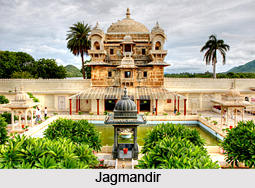 Jagmandir lies near the charming Pichola Lake. It is a palace and its construction was started by Maharana Amar Singh. However the palace was genuinely developed by Rana Karan Singh. A lot of historical significance is associated with this palace. One of the structures within this palace had been specially built to provide shelter to Shah Jahan while he was still a prince. The prince revolted against his father and the then emperor, Jahangir. According to legends Shah Jahan was initially made to stay at the City Palace. But later they were shifted to this palace on the banks of Lake Pichola.
Jagmandir lies near the charming Pichola Lake. It is a palace and its construction was started by Maharana Amar Singh. However the palace was genuinely developed by Rana Karan Singh. A lot of historical significance is associated with this palace. One of the structures within this palace had been specially built to provide shelter to Shah Jahan while he was still a prince. The prince revolted against his father and the then emperor, Jahangir. According to legends Shah Jahan was initially made to stay at the City Palace. But later they were shifted to this palace on the banks of Lake Pichola.
Prince Karan Singh was asked to act as the envoy to the Mughal court. During this time a friendship developed between the Mughals and the Sisodiya rulers. As is the norm of the Rajputs the Mughal prince was treated with hospitality and a domed pavilion was built for Shah Jahan. The interiors of the palace were lavishly done. A throne and a mosque were built for the guest. It is said that the pietra dura work in the interior of the palace later inspired Shah Jahan while he commissioned the construction of Taj Mahal.
Jagmandir is built in sandstone. The palace flaunts designs in onyx, jasper and agate. This palace was further extended by Jagat Singh. He added women`s quarters and it is known as zenana. He also named the palace after him. Till date the palace is known by his name-Jagmandir. As one proceeds towards Jag Niwas eight elephant statues will lead the way. This part of the palace is known as the Gul Mahal. This section was built by Karan Singh during 1625 to 27.
Jagmandir in Udaipur is one of those rare monuments in Udaipur that reflect the Mughal influence on Rajasthani style of architecture.



















